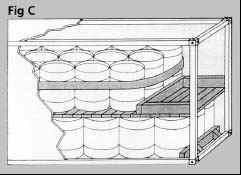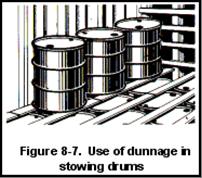Oils and Liquids (in drums/containers)
| Infobox on Oils and Liquids (in drums/containers) | |
|---|---|
| Example of Oils and Liquids (in drums/containers) |  |
| Facts | |
| Origin | - |
| Stowage factor (in m3/t) | - |
| Humidity / moisture | - |
| Ventilation | - |
| Risk factors | - |
Oils and Liquids (in drums/containers)
Description / Shipment / Storage
Oils & liquids (hazardous/non hazardous) - stowage in drums, pails & jerry cans.
Oils (mineral, lubricating, vegetable) can be very messy to the equipment and is extremely difficult to clean up after a larger spill. Hence, special precautions need to be taken to protect the container. Following procedure is to be adopted for stuffing of oils or any other commodities required to be stowed in drums, cans, suitable Intermediate Bulk Containers (IBC) and tins:
1. Container floor from inside is to be protected with a heavy duty plastic sheeting extending a minimum of 30 cm on all 4 sides of the container
2. Carton/cardboard sheets are placed on floor of container
3. First layer of drums/tins are stuffed in container
4. Prior laying the 2nd layer: for large drums: protective PLYWOOD layer to be placed on top
5. For small tins: protective CARDBOARD layer to be placed on top (this is to prevent rubbing of drums against each other during transportation/transhipment of the containers)
6. 3rd layer - horizontal stuffing of drums is NOT ACCEPTABLE.


Only drums that are either new or in a good maintenance state and clean prior to stuffing are to be used.
After stuffing, the drums must be safely secured/braced to withstand a sea passage. Caution to be exercised with Webbing.
Please refer to the latest IMDG Code and RKDC for dangerous cargo commodities.
No commodity regulated under the IMDG Code are allowed in flexitanks. Some non dangerous commodities also cannot be accepted in Flexi-tanks.











